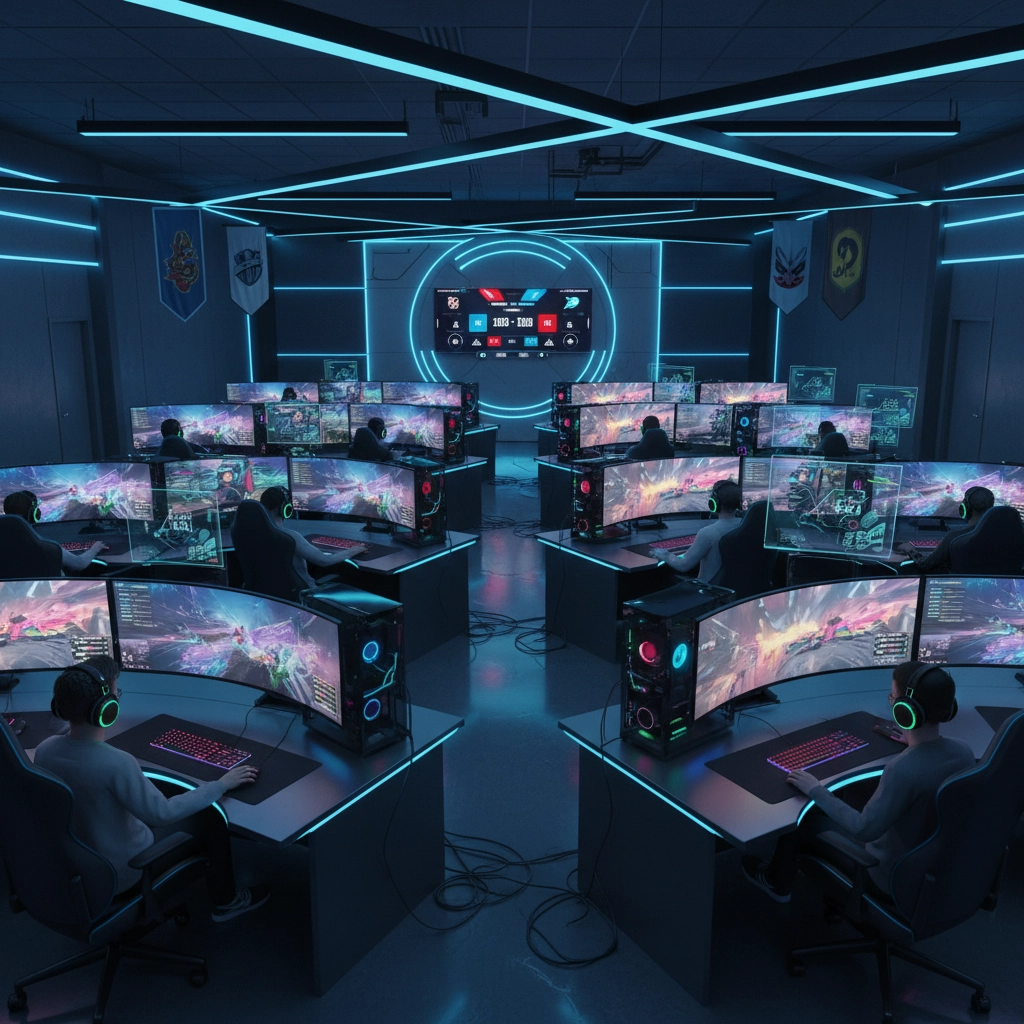The landscape of education continues to evolve, with districts across the country exploring innovative approaches to engage students and prepare them for future careers. One emerging model combines esports infrastructure with simulation-based learning to create comprehensive educational experiences. This case study examines the implementation of an Education by Simulation program, focusing on practical steps, challenges, and outcomes for district administrators.
Program Overview and Objectives
Education by Simulation programs integrate competitive gaming platforms with curriculum-based learning objectives. These programs utilize esports environments to teach critical thinking, teamwork, strategic planning, and technical skills. The model extends beyond traditional gaming to encompass business simulations, historical recreations, and scientific modeling exercises.
Districts implementing these programs typically target multiple educational outcomes. Students develop digital literacy skills essential for modern workplaces. Team-based competitions foster collaboration and communication abilities. Strategic gameplay elements enhance problem-solving capabilities and analytical thinking.

The program structure accommodates various learning styles and engagement levels. Visual learners benefit from interactive graphics and real-time feedback systems. Kinesthetic learners engage through hands-on control mechanisms and immediate response environments. Auditory learners participate in team communications and strategy discussions during gameplay sessions.
Infrastructure Requirements and Setup
Successful program implementation requires comprehensive infrastructure planning. Districts must evaluate existing technology resources and identify necessary upgrades or additions. Network capacity represents a critical consideration, as simulation platforms require stable internet connections and sufficient bandwidth for multiple concurrent users.
Hardware specifications vary depending on selected simulation platforms. Basic implementations may utilize existing computer labs with software installations. Advanced programs require dedicated gaming systems, specialized peripherals, and high-resolution display equipment.
Physical space allocation involves considerations beyond traditional classroom arrangements. Esports simulation environments benefit from flexible seating configurations that accommodate both individual work and team collaboration. Sound management becomes important when multiple groups operate simultaneously in shared spaces.
"Districts must balance infrastructure investments with long-term educational outcomes and sustainability considerations."
Technical support requirements extend beyond initial setup phases. Programs require ongoing maintenance, software updates, and troubleshooting capabilities. Districts often establish partnerships with technology vendors or develop internal expertise to manage these operational aspects.
Curriculum Integration and Academic Alignment
Effective Education by Simulation programs align with established academic standards rather than operating as isolated activities. Integration occurs across multiple subject areas, with simulation scenarios designed to reinforce specific learning objectives.
Mathematics integration utilizes statistical analysis of gameplay performance, resource management calculations, and strategic optimization problems. Students analyze data patterns, calculate probabilities, and apply mathematical concepts in practical contexts.

Science curriculum connections emerge through simulation environments that model physical systems, biological processes, or chemical reactions. Students observe cause-and-effect relationships, test hypotheses, and analyze experimental outcomes within controlled virtual environments.
Social studies integration occurs through historical simulations, geopolitical strategy games, and economic modeling exercises. Students experience decision-making processes faced by historical figures, analyze consequences of policy choices, and explore cultural interactions in simulated environments.
Language arts skills develop through written strategy guides, team communication protocols, and reflective analysis of simulation experiences. Students practice technical writing, collaborative editing, and persuasive argumentation within gaming contexts.
Student Engagement and Participation Strategies
Engagement strategies for Education by Simulation programs differ from traditional classroom approaches. Students assume active roles within simulation environments, making decisions that directly impact outcomes. This agency creates investment in learning processes and outcomes.
Competition elements motivate sustained participation while maintaining educational focus. District programs often establish tournament structures, achievement recognition systems, and skill progression pathways. These elements provide clear goals and measurable progress indicators for students.
Collaborative team structures address diverse skill levels and learning preferences within single cohorts. Teams typically include students with complementary strengths, encouraging peer teaching and mutual support. Rotation systems ensure all students experience different roles and responsibilities over time.
Assessment strategies incorporate both traditional academic measures and simulation-specific performance indicators. Students demonstrate learning through written reflections, strategic presentations, and peer evaluations. Performance data from simulation platforms provides additional feedback on decision-making processes and skill development.
Professional Development and Staff Training
Educator preparation represents a crucial implementation component. Staff members require training in simulation platform operation, educational integration techniques, and student management strategies within gaming environments.
Training programs address technical competencies alongside pedagogical approaches. Educators learn platform navigation, troubleshooting procedures, and content customization methods. Equal emphasis applies to facilitating meaningful learning experiences and maintaining classroom management in dynamic simulation environments.

Ongoing professional development supports program evolution and improvement. Regular workshops introduce new simulation options, share successful integration strategies, and address emerging challenges. Peer collaboration networks allow educators to exchange experiences and develop best practices.
Administrative support includes release time for training activities, resource allocation for professional development expenses, and recognition of additional time investments required for program implementation. Districts that provide comprehensive support systems observe higher levels of educator engagement and program sustainability.
Partnerships and Community Involvement
External partnerships enhance program resources and provide authentic connections to industry applications. Local businesses offer mentorship opportunities, career exploration sessions, and real-world context for simulation activities.
Higher education partnerships create pathways for advanced students and professional development opportunities for educators. University programs in game design, computer science, and educational technology provide expertise and research collaboration possibilities.
Community organizations contribute through volunteer support, venue availability for competitions, and broader public awareness initiatives. These partnerships demonstrate district commitment to innovative education and community engagement.
Assessment and Evaluation Methods
Program evaluation encompasses multiple data sources and measurement approaches. Traditional academic assessments measure knowledge acquisition and skill development aligned with curriculum standards. Standardized test performance provides comparative data for program effectiveness evaluation.
Simulation-specific metrics include completion rates, performance improvement over time, and collaborative effectiveness indicators. Platform analytics provide detailed information about student engagement patterns, decision-making processes, and learning progression.
Qualitative assessment methods capture student experiences and engagement levels through surveys, focus groups, and individual interviews. These data sources provide insights into program impact beyond quantifiable academic outcomes.
Long-term tracking examines student retention in STEM fields, post-secondary education choices, and career pathway selections. These indicators help districts evaluate program effectiveness in preparing students for future opportunities.
Budget Considerations and Funding Sources
Education by Simulation program costs vary significantly based on scope, technology requirements, and implementation timeline. Initial expenses include hardware purchases, software licensing, infrastructure upgrades, and staff training investments.
Ongoing operational costs encompass software subscriptions, maintenance agreements, professional development activities, and replacement equipment. Districts must plan for sustainable funding sources beyond initial startup investments.
Funding opportunities include federal education technology grants, state innovation initiatives, and private foundation support for educational advancement. Corporate partnerships may provide equipment donations, software licensing arrangements, or direct financial support.
Cost-benefit analysis considers both quantifiable expenses and broader educational value propositions. Districts evaluate program costs against student engagement improvements, academic achievement gains, and preparation for future career opportunities.
The implementation of Education by Simulation programs requires comprehensive planning, sustained commitment, and ongoing evaluation. Districts that approach these initiatives systematically while maintaining focus on educational outcomes can create engaging learning environments that prepare students for increasingly digital future opportunities.
